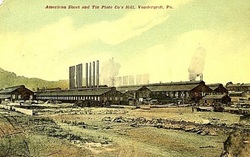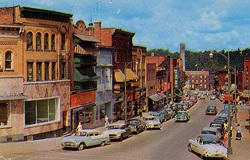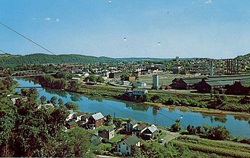Founded in 1895, Vandergrift was the first successful planned industrial town designed to be sold to its workers. George McMurtry, president of the Apollo Iron & Steel Co., Apollo, PA., needed to expand his successful galvanized steel operations. Beset with labor problems and unable to acquire additional land, he selected a 650-acre farm site a few miles downstream on the Kiskimenetas River, some forty miles from Pittsburgh. He than approached the designer of the 1893 Chicago World's Fair, Frederick Law Olmsted, to design a town that would be "something better than the best." The result was Vandergrift,
(named for Capt. J.J. Vandergrift, a director of the steel company).
(named for Capt. J.J. Vandergrift, a director of the steel company).
Vandergrift, PA - Early 1900's

In the 1890s the Apollo Iron and Steel Company ended a bitterly contested labor dispute by hiring replacement workers from the surrounding countryside. To avoid future unrest, however, the company sought to gain tighter control over its workers not only at the factory but also in their homes. Drawing upon a philosophy of reform movements in Europe and the United States, the firm decided that providing workers with good housing and a good urban environment would make them more loyal and productive. In 1895, Apollo Iron and Steel built a new, integrated, non-unionized steelworks and hired the nation's preeminent landscape architectural firm, Olmsted, Olmsted and Eliot, to design the model industrial town: Vandergrift. Vandergrift, Pennsylvania – before and after July 1895, before construction of the town.
May 1896
Mosher (1995) shows how Vandergrift was representative of the new industrial suburbs of Pittsburgh. Caught up in a dramatic round of industrial restructuring and labor tension, Pittsburgh steelmaker George McMurtry hired Frederick Law Olmsted's landscape architectural firm in 1895 to design Vandergrift as a model town. McMurtry believed in what was later known as welfare capitalism, with the company going beyond paychecks to provide for the social needs of the workers; he believed that a benign physical environment made for happier and more productive workers. A strike and lockout at McMurtry's steelworks in Apollo, Pennsylvania, had prompted him to build the new town. Wanting a loyal workforce, he developed a town agenda that drew upon environmentalism as well as popular attitudes toward capital's treatment of labor. The Olmsted firm translated this agenda into an urban design that included a unique combination of social reform, comprehensive infrastructure planning, and private homeownership principles. The rates of homeownership and cordial relationships between the steel company and Vandergrift residents fostered loyalty among McMurtry's skilled workers and led to McMurtry's greatest success. In 1901 he
used Vandergrift's worker-residents to break the first major strike against the United States Steel Corporation.[1]
St. Gertrude Roman Catholic Church and the Vandergrift Historic District are listed on the National Register of Historic Places.[2]
May 1896
Mosher (1995) shows how Vandergrift was representative of the new industrial suburbs of Pittsburgh. Caught up in a dramatic round of industrial restructuring and labor tension, Pittsburgh steelmaker George McMurtry hired Frederick Law Olmsted's landscape architectural firm in 1895 to design Vandergrift as a model town. McMurtry believed in what was later known as welfare capitalism, with the company going beyond paychecks to provide for the social needs of the workers; he believed that a benign physical environment made for happier and more productive workers. A strike and lockout at McMurtry's steelworks in Apollo, Pennsylvania, had prompted him to build the new town. Wanting a loyal workforce, he developed a town agenda that drew upon environmentalism as well as popular attitudes toward capital's treatment of labor. The Olmsted firm translated this agenda into an urban design that included a unique combination of social reform, comprehensive infrastructure planning, and private homeownership principles. The rates of homeownership and cordial relationships between the steel company and Vandergrift residents fostered loyalty among McMurtry's skilled workers and led to McMurtry's greatest success. In 1901 he
used Vandergrift's worker-residents to break the first major strike against the United States Steel Corporation.[1]
St. Gertrude Roman Catholic Church and the Vandergrift Historic District are listed on the National Register of Historic Places.[2]
Curving Streets

Curving Streets
Vandergrift is a town with gently curving streets that follow the natural slope of the hills. Everything was made ready in advance: The steel mill was built. The streets were graded, utilities were installed (including water, natural gas, electric lines, and sewer lines). Streets and sidewalks were paved, trees were planted, and street lights were erected. Finally, free lots and ha...lf the cost of construction were offered to the churches. Then, when everything was in readiness, the building lots were offered for sale to the workers so that they could build their own homes. In 1895, this was a unique idea in America—that a company would build a town entirely in
advance and then turn over its control to the workers.
Vandergrift is a town with gently curving streets that follow the natural slope of the hills. Everything was made ready in advance: The steel mill was built. The streets were graded, utilities were installed (including water, natural gas, electric lines, and sewer lines). Streets and sidewalks were paved, trees were planted, and street lights were erected. Finally, free lots and ha...lf the cost of construction were offered to the churches. Then, when everything was in readiness, the building lots were offered for sale to the workers so that they could build their own homes. In 1895, this was a unique idea in America—that a company would build a town entirely in
advance and then turn over its control to the workers.
Success and Accolades

Success and Accolades
The town's success came swiftly. Soon the mill became the world's largest rolling mill, hundreds of private homes were built, the population swelled to 11,000, and a delegation from the British Parliament came to study its success. In 1904, when a model of the town was displayed at the St. Louis World's Fair, the town's design won two gold medals.
In 1915, Vandergrift merged... with Vandergrift Heights, and in 1957, West
Vandergrift was annexed. In 1988, the steel mill was purchased by Allegheny Ludlum Corporation, specialty steel makers, and is a "state of the art" mill today. Nearly a century after its founding, the town remains eighty to ninety percent intact, its Queen Ann & Victorian homes are architectural treasures ideal for restoration, its awareness of its unique heritage growing, and its
outlook for the second century optimistic. The town is now listed on the National Register of Historic Places.
(This information came from the
Vandergrift Public Library)
The town's success came swiftly. Soon the mill became the world's largest rolling mill, hundreds of private homes were built, the population swelled to 11,000, and a delegation from the British Parliament came to study its success. In 1904, when a model of the town was displayed at the St. Louis World's Fair, the town's design won two gold medals.
In 1915, Vandergrift merged... with Vandergrift Heights, and in 1957, West
Vandergrift was annexed. In 1988, the steel mill was purchased by Allegheny Ludlum Corporation, specialty steel makers, and is a "state of the art" mill today. Nearly a century after its founding, the town remains eighty to ninety percent intact, its Queen Ann & Victorian homes are architectural treasures ideal for restoration, its awareness of its unique heritage growing, and its
outlook for the second century optimistic. The town is now listed on the National Register of Historic Places.
(This information came from the
Vandergrift Public Library)